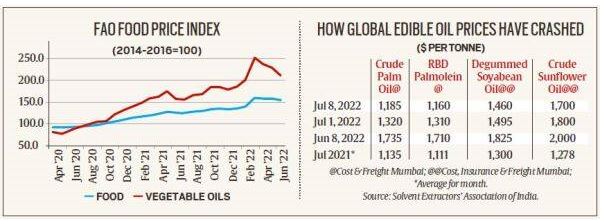

11th July 2022 (8 Topics)
Context
The government recently directed the edible oil manufacturers to further cut the maximum retail price (MRP) of imported cooking oils by up to Rs 10 per litre within a week, and maintain a uniform MRP of the same brand of oil across the country.
About
India’s Consumption:
- India annually consumes around 23 million tonnes (mt) of edible oils, out of which
- 5-14.5 mt is imported and
- 5-9.5 mt domestically produced
- India meets 56% of its annual edible oil consumption via imports.
- The imported oils mainly comprise
- palm (8-9 mt),
- soyabean (3-3.5 mt) and
- sunflower (2-2.5 mt),
- Indigenously sourced include
- mustard (2.5-2.8 mt),
- soyabean and cottonseed (1.2-1.3 mt each),
- rice bran (1-1.1 mt) and
- groundnut (0.5-0.8 mt)
- The effective import duty is currently 5.5% on crude palm, soyabean and sunflower oil, while it is 13.75% for RBD palmolein.
- Around 8 MT of palm oil is imported from Indonesia and Malaysia, while other oils such as soya and sunflower come from Argentina, Brazil, Ukraine and Russia.
Palm Oil:
- Being a ‘hard’ oil that is semi-solid (as opposed to liquid) at room temperature, palm oil isn’t used much in home kitchens for direct cooking or frying.
- Most of it goes to make hydrogenated fats (vanaspati, margarine and bakery shortening) or as key ingredient in bread, biscuits, cookies, cakes, noodles, mithai, namkeen, frozen dessert, soap, and cosmetics.
- The benefits of the slide mainly in palm oil prices will thus accrue more to the food, restaurant, or skincare industries than to households.
- They would want prices of ‘soft’ (soyabean and sunflower) and indigenous (mustard and groundnut) oils to fall more.
More Articles


